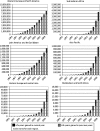Estimating the impact of antiretroviral therapy: regional and global estimates of life-years gained among adults
- PMID: 21106518
- PMCID: PMC3173805
- DOI: 10.1136/sti.2010.046060
Estimating the impact of antiretroviral therapy: regional and global estimates of life-years gained among adults
Abstract
Objective: An estimated 4.9 million adults received antiretroviral therapy (ART) in low and middle income countries in 2009. A further estimated 700 000 adults received ART in high-income countries. The impact of providing ART is not often quantifiable due to limited monitoring systems. One measure, life-years gained, provides a standardised measure that shows the survival impact of ART on the population while controlling for variations in underlying survival. Measuring life-years gained allows a comparison of the impact of ART between regions.
Methods: Using the Spectrum computer package, two different scenarios were created for 151 countries. One scenario describes the results of providing adults with ART as reported by countries between 1995 and 2009, the second scenario describes a situation in which no ART was provided to adults living with HIV between 1995 and 2009. The difference in the number of life-years accrued among adults in the two scenarios is compared and summarised by geographical region.
Results: An estimated 14.4 million life-years have been gained among adults globally between 1995 and 2009 as a result of ART. 54 % of these years were gained in western Europe and North America, where ART has been available for over 10 years. In recent years the growth in life-years has occurred more rapidly in sub-Saharan Africa and Asia.
Discussion: The substantial impact of ART described here provides evidence to argue for continued support of sustainable ART programmes in low and middle-income countries. Strengthening ART monitoring systems and mortality surveillance in low and middle-income countries will make this evidence more accessible to programme managers.
Conflict of interest statement
Figures



Similar articles
-
One world, one hope: the cost of providing antiretroviral therapy to all nations.AIDS. 1998 Nov 12;12(16):2203-9. doi: 10.1097/00002030-199816000-00016. AIDS. 1998. PMID: 9833862
-
Estimating the impact of antiretroviral treatment on adult mortality trends in South Africa: A mathematical modelling study.PLoS Med. 2017 Dec 12;14(12):e1002468. doi: 10.1371/journal.pmed.1002468. eCollection 2017 Dec. PLoS Med. 2017. PMID: 29232366 Free PMC article.
-
Global estimates of HIV infections and AIDS cases: 1991.AIDS. 1991;5 Suppl 2:S57-61. doi: 10.1097/00002030-199101001-00009. AIDS. 1991. PMID: 1845061
-
Contemporary issues on the epidemiology and antiretroviral adherence of HIV-infected adolescents in sub-Saharan Africa: a narrative review.J Int AIDS Soc. 2015 Sep 16;18(1):20049. doi: 10.7448/IAS.18.1.20049. eCollection 2015. J Int AIDS Soc. 2015. PMID: 26385853 Free PMC article. Review.
-
Alcohol Use and Antiretroviral Therapy Non-Adherence Among Adults Living with HIV/AIDS in Sub-Saharan Africa: A Systematic Review and Meta-Analysis.AIDS Behav. 2020 Jun;24(6):1727-1742. doi: 10.1007/s10461-019-02716-0. AIDS Behav. 2020. PMID: 31673913 Free PMC article.
Cited by
-
HIV protease inhibitors in pregnancy : pharmacology and clinical use.Drugs. 2013 Mar;73(3):229-47. doi: 10.1007/s40265-013-0017-3. Drugs. 2013. PMID: 23404092 Review.
-
In vivo expressed biologics for infectious disease prophylaxis: rapid delivery of DNA-based antiviral antibodies.Emerg Microbes Infect. 2020 Dec;9(1):1523-1533. doi: 10.1080/22221751.2020.1787108. Emerg Microbes Infect. 2020. PMID: 32579067 Free PMC article.
-
Derivation of parameters used in Spectrum for eligibility for antiretroviral therapy and survival on antiretroviral therapy.Sex Transm Infect. 2010 Dec;86 Suppl 2(Suppl_2):ii28-34. doi: 10.1136/sti.2010.044255. Sex Transm Infect. 2010. PMID: 21106512 Free PMC article.
-
Lymph nodes cytology in HIV seropositive cases with haematological alterations.Indian J Med Res. 2014 Feb;139(2):301-7. Indian J Med Res. 2014. PMID: 24718407 Free PMC article.
-
Comparison of different cardiovascular risk tools used in HIV patient cohorts in sub-Saharan Africa; do we need to include laboratory tests?PLoS One. 2021 Jan 28;16(1):e0243552. doi: 10.1371/journal.pone.0243552. eCollection 2021. PLoS One. 2021. PMID: 33507945 Free PMC article.
References
-
- UNAIDS UNICEF WHO Report on the Global AIDS Epidemic 2010. Geneva: Joint UN Programme on HIV/AIDS
-
- World Health Organization UNICEF, UNAIDS. Towards Universal Access. Geneva, Switzerland: World Health Organization, 2010
MeSH terms
Substances
LinkOut - more resources
Full Text Sources
Medical
